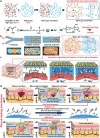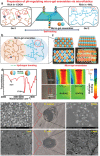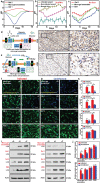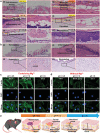Micro-Gel Ensembles for Accelerated Healing of Chronic Wound via pH Regulation
- PMID: 35596608
- PMCID: PMC9353480
- DOI: 10.1002/advs.202201254
Micro-Gel Ensembles for Accelerated Healing of Chronic Wound via pH Regulation
Abstract
The pH value in the wound milieu plays a key role in cellular processes and cell cycle processes involved in the process of wound healing. Here, a microfluidic assembly technique is employed to fabricate micro-gel ensembles that can precisely tune the pH value of wound surface and accelerate wound healing. The micro-gel ensembles consist of poly (hydroxypropyl acrylate-co-acrylic acid)-magnesium ions (poly-(HPA-co-AA)-Mg2+ ) gel and carboxymethyl chitosan (CMCS) gel, which can release and absorb hydrogen ion (H+ ) separately at different stages of healing in response to the evolution of wound microenvironment. By regulating the wound pH to affect the proliferation and migration of cell on the wound and the activity of various biological factors in the wound, the physiological processes are greatly facilitated which results in much accelerated healing of chronic wound. This work presents an effective strategy in designing wound healing materials with vast potentials for chronic wound management.
Keywords: accelerated wound healing; chronic wound; micro-gel ensembles; microfluidic assembly; wound pH regulation.
© 2022 The Authors. Advanced Science published by Wiley-VCH GmbH.
Conflict of interest statement
The authors declare no conflict of interest.
Figures





Similar articles
-
Moist-Retaining, Self-Recoverable, Bioadhesive, and Transparent in Situ Forming Hydrogels To Accelerate Wound Healing.ACS Appl Mater Interfaces. 2020 Jan 15;12(2):2023-2038. doi: 10.1021/acsami.9b17180. Epub 2020 Jan 2. ACS Appl Mater Interfaces. 2020. PMID: 31895528
-
[Advances in the effects of pH value of micro-environment on wound healing].Zhonghua Shao Shang Za Zhi. 2016 Apr;32(4):240-2. doi: 10.3760/cma.j.issn.1009-2587.2016.04.012. Zhonghua Shao Shang Za Zhi. 2016. PMID: 27093935 Review. Chinese.
-
Carboxymethyl chitosan nanoparticles loaded with bioactive peptide OH-CATH30 benefit nonscar wound healing.Int J Nanomedicine. 2018 Sep 25;13:5771-5786. doi: 10.2147/IJN.S156206. eCollection 2018. Int J Nanomedicine. 2018. PMID: 30310280 Free PMC article.
-
EGCG-crosslinked carboxymethyl chitosan-based hydrogels with inherent desired functions for full-thickness skin wound healing.J Mater Chem B. 2022 May 25;10(20):3927-3935. doi: 10.1039/d2tb00074a. J Mater Chem B. 2022. PMID: 35485772
-
Influence of pH on wound-healing: a new perspective for wound-therapy?Arch Dermatol Res. 2007 Feb;298(9):413-20. doi: 10.1007/s00403-006-0713-x. Epub 2006 Nov 8. Arch Dermatol Res. 2007. PMID: 17091276 Review.
Cited by
-
Tuning oxidant and antioxidant activities of ceria by anchoring copper single-site for antibacterial application.Nat Commun. 2024 Feb 3;15(1):1010. doi: 10.1038/s41467-024-45255-6. Nat Commun. 2024. PMID: 38307902 Free PMC article.
-
Nanomaterials-Functionalized Hydrogels for the Treatment of Cutaneous Wounds.Int J Mol Sci. 2022 Dec 25;24(1):336. doi: 10.3390/ijms24010336. Int J Mol Sci. 2022. PMID: 36613778 Free PMC article. Review.
-
3D-Printed Hydrogel Scaffolds Loaded with Flavanone@ZIF-8 Nanoparticles for Promoting Bacteria-Infected Wound Healing.Gels. 2024 Dec 18;10(12):835. doi: 10.3390/gels10120835. Gels. 2024. PMID: 39727592 Free PMC article.
-
Exudate Unidirectional Pump to Promote Glucose Catabolism Triggering Fenton-Like Reaction for Chronic Diabetic Wounds Therapy.Adv Sci (Weinh). 2024 Oct;11(38):e2404652. doi: 10.1002/advs.202404652. Epub 2024 Aug 9. Adv Sci (Weinh). 2024. PMID: 39120461 Free PMC article.
-
Metallic elements combine with herbal compounds upload in microneedles to promote wound healing: a review.Front Bioeng Biotechnol. 2023 Nov 3;11:1283771. doi: 10.3389/fbioe.2023.1283771. eCollection 2023. Front Bioeng Biotechnol. 2023. PMID: 38026844 Free PMC article. Review.
References
-
- Gurtner G. C., Werner S., Barrandon Y., Longaker M. T., Nature 2008, 453, 314. - PubMed
-
- Mao C., Xiang Y., Liu X., Cui Z., Yang X., Li Z., Zhu S., Zheng Y., Yeung K. W. K., Wu S., ACS Nano 2018, 12, 1747. - PubMed
-
- Martin P., Science 1997, 276, 75. - PubMed
-
- Tan Q.‐W., Tang S.‐L., Zhang Y., Yang J.‐Q., Wang Z.‐L., Xie H.‐Q., Lv Q., J. Invest. Dermatol. 2019, 139, 455. - PubMed
Publication types
MeSH terms
Substances
Grants and funding
LinkOut - more resources
Full Text Sources
